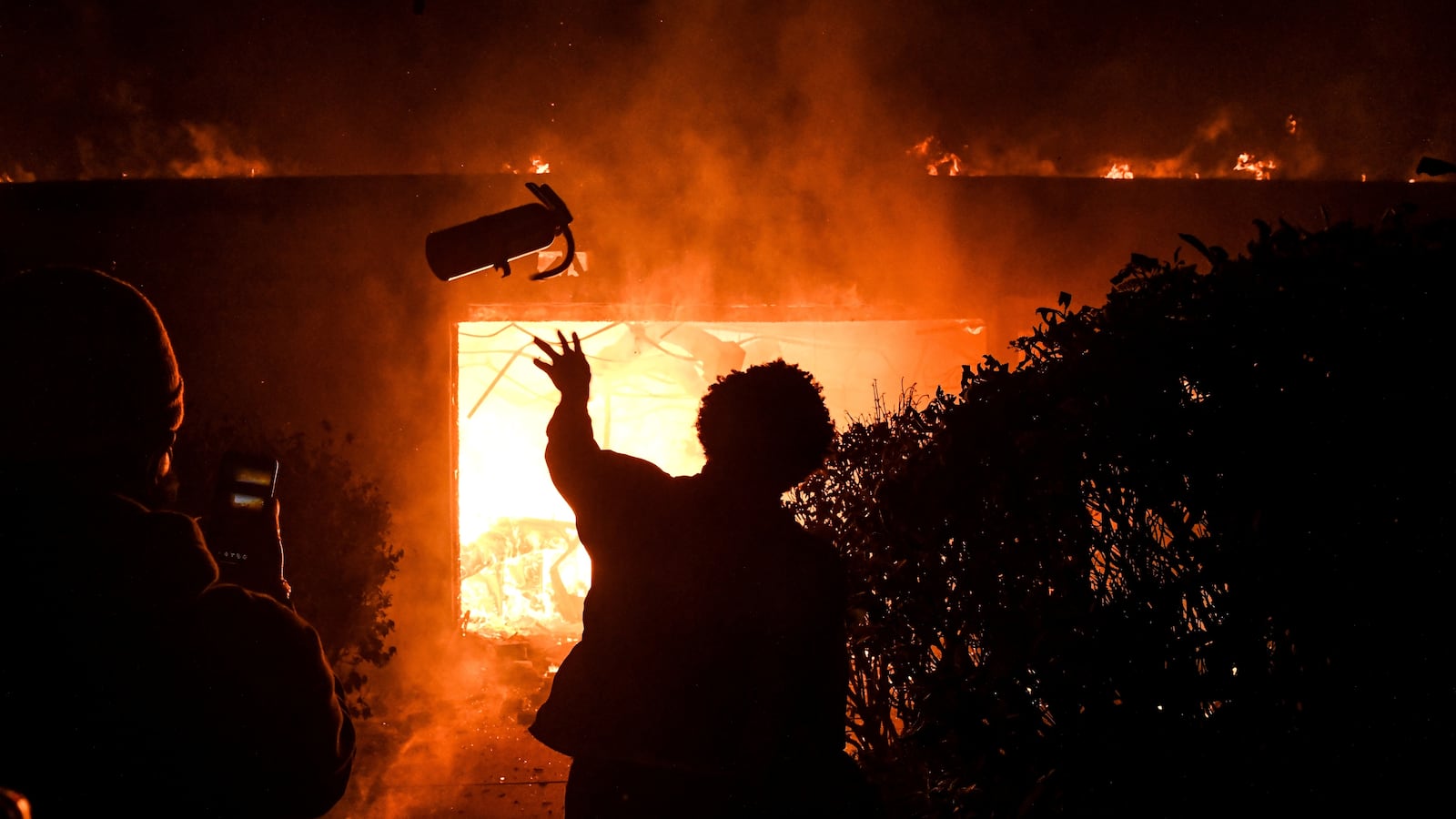Dozens of U.S. cities were still reeling from a brutal wave of protests when violence spread further across the nation Saturday—with patrol cars torched, buildings set ablaze, cops attacked, and police firing tear gas and rubber bullets at crowds from coast to coast.
Police and military reinforcements, curfews in major metropolitan areas, and impassioned scoldings from elected officials did little to quell the rage that erupted after a day of mostly peaceful demonstrations over the death of George Floyd.
As late afternoon bled into evening and night fell, reports of clashes from Buffalo to Seattle began pouring in, raising the question of how long the nationwide unrest might last, and how it might end.
Whether it was Philadelphia or Washington or New York, the confrontations unfolded with a sudden ferocity. Bank windows were smashed, anti-police slogans were scrawled on squad cars with busted windshields, infernos dotted the landscape. By Sunday morning, more than 1,400 people had been arrested across 22 cities, according to NPR. More than 345 people were arrested in New York City overnight alone.
Elected officials blamed outsiders for fueling the anarchy, which resulted in hundreds of arrests, injury to both police and civilians, and massive destruction.
Clashes between police and protesters were reported in cities large and small—Fayetteville, North Carolina; Rochester, New York; Grand Rapids, Michigan; Cleveland, San Diego, and Los Angeles.
One person was killed in Indianapolis and several others were shot as police investigated “multiple shootings” across the city. IMPD Police Chief Randal Taylor said in a late-night press conference that no officers were involved in any of the shootings among protesters. “Enough is enough,” he said. “Indianapolis, we are better than this. Downtown is not safe at this time.”
In Chicago, a brawl broke out between demonstrators and police officers, and a video posted to Twitter showed three cops outnumbered by a mob that descended and began beating them, while others tried to shield them.
Police vehicles were also smashed up, the tires slashed, and some demonstrators threw eggs at police officers. Police shut down Lake Shore Drive in both directions.
Mayor Lori Lightfoot gave the agitators a tongue-lashing, drawing a distinction between those genuinely grieving Floyd, who died while a white cop knelt on his neck, and those who came armed for what she described as “all-out battle.”
“You don’t come to a peaceful protest with a bowling ball,” she thundered. “You don’t come to a peaceful protest with bottles of urine to throw at police.”
Just near the White House around Lafayette Park, protesters moved from street to street, engaging in skirmishes and shouting matches with D.C. police.
Tear gas and flash-bangs were deployed on several major intersections just a stone’s throw from the West Wing and other federal buildings. Fires were lit, windows broken, bottles hurled. Several local businesses were defaced with “FUCK TRUMP” and “FUCK 12” graffiti. And crowds of demonstrators and activists traded chants: “Hands Up, Don’t Shoot” versus police orders to “Move BACK, Move BACK, Move BACK.”
Through it all, President Trump followed the action closely, with his senior aides debating into the evening the best course of action, according to two administration officials.“Tonight in Washington, I see another chance for him to be the law and order [president],” a White House official messaged The Daily Beast around 11:30 p.m. as the standoffs in the streets continued apace.
New York City was gripped by conflict for the second night as the NYPD squared off against hundreds of people out on the streets of Manhattan and Brooklyn. One of the most disturbing scenes of the night was video of an NYPD SUV that appeared to be deliberately driven through protesters blocking its way or clambering onto it.
In Flatbush, an NYPD squad car was set ablaze and a van was smashed—prompting police to deploy mace and make arrests. Protesters were seen throwing bottles of water at officers, and at least one cop was hit with a piece of concrete in the neck.
In Manhattan, near Union Square, several hundred protesters had been peaceful, even dancing in the streets, before the tenor suddenly shifted. Shop windows were smashed in and at least four NYPD vehicles were set on fire, the crowd cheered every time one of the cars exploded.
Amira Dunn, 23, said the police response varied—from aggressive cops who aggressively corralled crowds to others who seemed almost “humble.”
“There’s so much hatred, so much insecurity but I looked some in the eye and it looked like they were gonna cry,” she said.
As the night went on, it seemed like every major city had become a flashpoint.
Miami streets were filled with smoke as several cars burned and police deployed tear gas in a bid to disperse protesters—and against that dystopian backdrop fireworks suddenly lit up the sky as part of a previously scheduled display to honor health-care workers.
Seattle protesters took over roadways, shattered store windows, and several cars were set on fire. One protester was spotted carrying around an AR-15, but was quickly disarmed by a security guard. With almost no notice, the mayor imposed a 5 p.m. curfew due to the “extremely dangerous situation” unfolding in the city.
Rallies in Philadelphia abruptly spun out of control, with some in the crowds smashing in windows at City Hall and setting off fireworks. Footage showed several police vehicles on fire, and the Philadelphia Inquirer reported that demonstrators had begun hurling things at SWAT officers. The police commissioner later said at least 13 officers had been injured, and there were also reports of looting.
A police officer’s throat was slashed in Jacksonville, Florida, where peaceful protests suddenly turned violent. Sheriff Mike Williams told reporters that the officer was “stabbed or slashed in the neck and is currently in the hospital.” Williams said other officers were pelted with rocks and bricks and that several arrests had been made.
In Minneapolis, after a night of widespread mayhem and destruction, Minnesota Gov. Tim Walz started the day by announcing that he was fully mobilizing the state’s National Guard for the first time. The Minnesota Department of Public Safety said its law enforcement presence had tripled “to address a sophisticated network of urban warfare.”
The fifth day of protests there brought the largest crowds so far, and the mood among protesters was calm after several days of “absolute chaos” that Walz said was caused largely by outsiders. Highways into the city were shut down to stop interlopers from rushing in to join whatever fray might emerge.
Attorney General William Barr said Saturday he believed recent protests around the country were the work of radical elements. “Unfortunately, with the rioting that is occurring in many cities around our country, the voices of peaceful protest are being hijacked by violent radical elements,” he said in a taped address. “In many places it appears the violence is planned, organized, and driven by anarchic and far left extremist groups using Antifa-like tactics, many of whom travel from outside the state to promote the violence.”
As soon as the 8 p.m. curfew passed, police and National Guard members moved in with force and began lobbing tear gas at any protesters still in the streets. And while journalists are exempt from the curfew, members of the news media came under fire as well.
MSNBC’s Ali Velshi said on Twitter that he was hit in the leg with a rubber bullet after “State Police supported by National guard fired unprovoked into an entirely peaceful rally.” A CNN producer was also hit by police with a projectile live on the air while Omar Jimenez was reporting from the scene.
Protesters, meanwhile, had lauded themselves on keeping the demonstration peaceful.
“I’m a strong believer of predefined protest. Not every day has been like that. Today, I’m very proud of the very peaceful protest,” James Holmes told The Daily Beast. “Most of the destruction cane from people from out of state, people who are not part of the justice for George Floyd protest,” he said.
Another Minneapolis demonstrator, Mike Earney, condemned the looting that had taken place throughout the city because he said it distracts from the very injustice they are trying to highlight.
“But I will say that I have been beat by the police at the 3rd Precinct within an inch of my life. Yes, I was happy to see it burn. It was like seeing Obama win the presidency,” he said.
—with additional reporting by Rachel Olding, Lachlan Cartwright and Barbie Latza Nadeau





